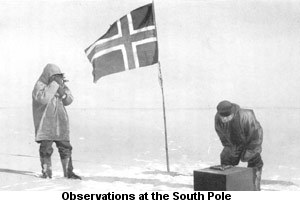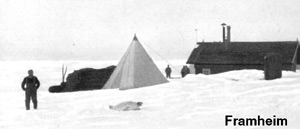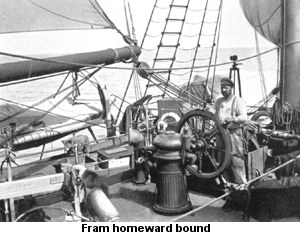
| Glasgow Digital Library | Voyage of the Scotia | BRUCE | PEOPLE | SHIP | ANTARCTIC | INDEX |
|---|

On 11 December, with a temperature of -25°C, latitude 89°15'S was reached. On 14 December, by 'dead reckoning', they were at the South Pole. The exact latitude of a place can be ascertained by taking the angle of the sun above the horizon with a sextant. The position of the sun above the Earth at any time can be found in a nautical almanac. An accurate observation requires a clear sky and a clear horizon or the use of an artificial horizon. Amundsen's party spent three days at the pole taking observations. They also made several trips in each direction to make sure they had been at the pole. This would have been much easier using today's global positioning system.
'I had better be honest and admit straight out that I have never known any man to be placed in such a diametrically opposite position to the goal of his desires as I was at that moment. The regions around the North Pole - well, yes, the North Pole itself - had attracted me from childhood and here I was at the South Pole. Can anything more topsy turvy be imagined?'
Amundsen
On 17 December they started the journey back to Framheim. A tent was left behind with the Norwegian flag flying from a four-metre (13-foot) pole. Some items of gear were left in the tent along with a letter to Captain Scott who was to reach the pole one month later.

The pace home was very quick and they averaged 36km (22.5 miles) per day. At the end of each day the party was very hungry - particularly the ski runners - but there was ample food and the party actually put on weight on the way back from the pole. A special celebration dinner was held on Christmas Day - home-made porridge followed by cigars. On 26 December they were at 88°S.
On 28 December the descent from the plateau began 'at a swinging pace', and by 30 December 87°S had been passed. Temperatures were quite high, at -16°C. Brakes had to be used on the sledges to slow the descent. The ski runners fixed their poles together so that they could steer better.
On 6 January 1912 the party was at the 85°S depot on the ice barrier. Twelve dogs now remained from the polar party. The temperature rose to -10°C and at 84°26'S two skuas were seen, halfway between Poleheim and Framheim.
On 25 January the party arrived back in Framheim - right on schedule - with 11 dogs and two sledges after a journey of 99 days and 3,000km (1,860 miles). The Fram arrived the next day.
In January another ship came into the Bay of Whales. This was the Japanese ship Kainan Maru. She had come to explore Edward VII Land.

Fram sailed from Framheim on 30 January and by 6 February she was clear of the pack ice and heading for Hobart in Tasmania. At Hobart, Amundsen met up with Dr Mawson who was about to set out on an Australian Antarctic Expedition. The remaining 39 dogs from Fram were transferred to Aurora for a second trip to the Antarctic.
The two-volume book South Pole was published before the end of 1912, and at the time of publication there was no news from the Scott expedition to the Pole. Scott's party were already all dead.
Amundsen continued his interest in the Arctic, particularly from the air. In 1926 he made the first crossing of the North Pole in the airship Norge from King's Bay in Spitsbergen to Telfer in Alaska. Amundsen died in 1928 in a seaplane hunting for the lost airship Italia.

| Glasgow Digital Library | Voyage of the Scotia | BRUCE | PEOPLE | SHIP | ANTARCTIC | INDEX |
|---|